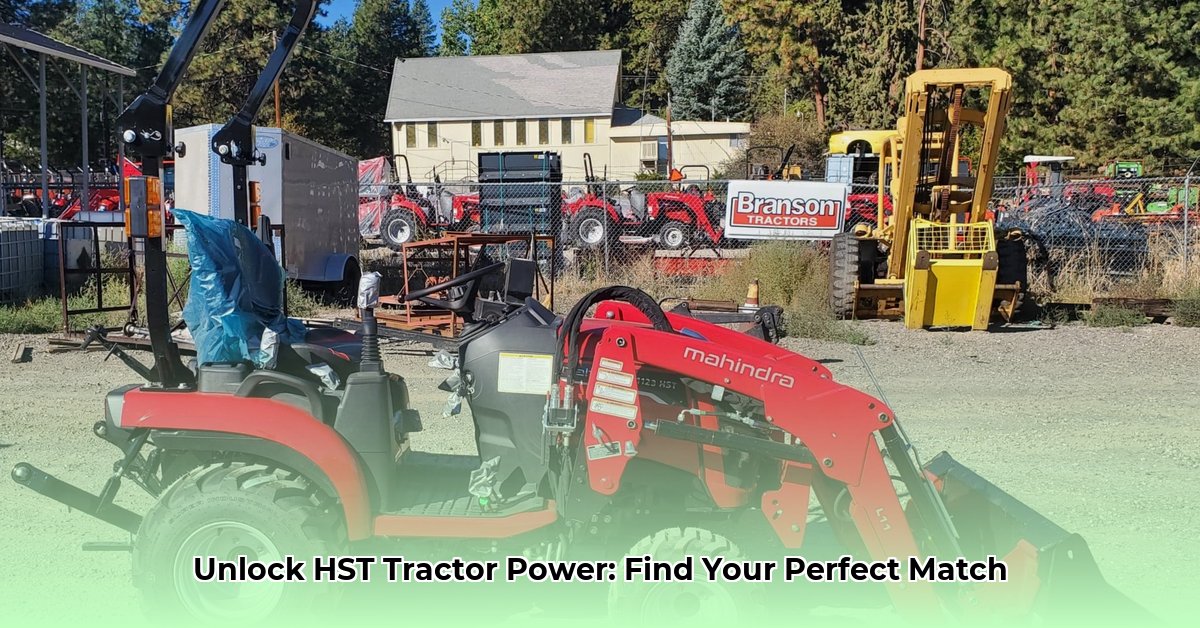
Choosing the right tractor transmission is crucial for farm efficiency and profitability. This guide compares hydrostatic (HST) and shuttle shift transmissions, helping you select the ideal option for your operation. We'll analyze ease of use, power, maintenance, and cost of ownership, providing actionable insights for both seasoned farmers and those new to tractor operation. For more information on tractor models, check out this helpful resource: Ford Tractor Models.
Hydrostatic Transmission (HST) Tractors
HST tractors use hydraulic fluid to control speed and direction, offering stepless, infinitely variable speed control. This translates to incredibly smooth and precise operation, making them ideal for certain tasks.
HST Advantages:
- Effortless Operation: HST tractors are incredibly user-friendly, particularly beneficial for beginners or those seeking less physically demanding operation. They provide a seamless, intuitive driving experience.
- Precision Control: The ability to adjust speed infinitely allows for pinpoint accuracy, perfect for loader work, delicate seeding, or operations needing precise positioning.
- Smooth Operation: HSTs provide a remarkably smooth ride, minimizing jolts and jerks, enhancing both operator comfort and machine longevity.
HST Disadvantages:
- Power Limitations: HSTs might offer lower peak power output compared to shuttle shift transmissions, particularly under heavy load conditions like extensive plowing.
- Higher Initial Cost: HST tractors typically command a higher purchase price than equivalent shuttle shift models, although this varies by model and features.
- Maintenance Complexity: HST systems have more complex components, potentially leading to higher maintenance costs and the need for specialized knowledge or service.
Shuttle Shift Tractors
Shuttle shift transmissions use gears, similar to a manual car transmission, but with a convenient shuttle lever for quick forward/reverse changes. This provides distinct speed steps and typically delivers greater raw power.
Shuttle Shift Advantages:
- High Power Output: Shuttle shift transmissions generally deliver higher PTO horsepower, making them suitable for heavy-duty field work, such as plowing large fields or pulling heavy implements.
- Durability and Reliability: Known for their robust build, shuttle shift transmissions are less prone to major component failure, resulting in potentially lower long-term repair costs.
- Lower Initial Cost: Typically, shuttle shift tractors have a lower initial purchase price than comparable HST models, representing a more budget-friendly entry point.
Shuttle Shift Disadvantages:
- Limited Precision Control: The distinct gear steps limit precision control, making them less suitable for tasks requiring fine adjustments or slow, deliberate movements.
- Steeper Learning Curve: Operating a shuttle shift requires mastering clutch engagement and gear selection, imposing a learning curve for less experienced operators.
- Less Smooth Operation: The inherent nature of gear-shifting results in less smooth operation compared to the seamless transitions of an HST.
HST vs. Shuttle Shift: A Direct Comparison
This table summarizes the key differences to aid in your decision-making process:
| Feature | HST Tractor | Shuttle Shift Tractor |
|---|---|---|
| Ease of Use | Excellent | Good, but requires skill and experience |
| Precision Control | Superior | Lower |
| Power Output | Good, less optimal for heavy fieldwork | High, ideal for heavy fieldwork |
| Initial Cost | Typically Higher | Typically Lower |
| Maintenance | More complex, potentially higher costs | Simpler, generally lower costs |
| Best Suited For | Loader work, smaller farms, precise tasks | Large-scale farming, heavy-duty field work |
Choosing the Right Transmission for Your Farm
The best transmission depends on your specific operational needs and priorities.
Small-Scale Farmers: For smaller operations emphasizing precision and ease of use, the HST's intuitive operation and fine control are significant advantages. Loader work and tasks requiring delicate maneuvers will benefit substantially.
Large-Scale Farmers: Large-scale farmers prioritizing power and durability for heavy-duty field work should strongly consider a shuttle shift transmission. Its higher PTO horsepower and robust design are well-suited for extensive plowing, tillage, and other demanding applications.
Crop Type Considerations: The ideal transmission can also vary depending on the crops cultivated. Delicate crops may benefit from the precise control of an HST, while sturdier crops may not require the extra precision.
Maintenance and Troubleshooting
Regular maintenance is paramount for both HST and shuttle shift transmissions. Adhering to the manufacturer's recommended service intervals for fluid changes, filter replacements, and inspections is crucial for maximizing lifespan and minimizing repair costs. Addressing minor issues promptly prevents them from escalating into larger, more costly problems. Early detection and correction of potential issues dramatically extend the life of your transmission system.
Conclusion: Prioritize Your Needs
Selecting between an HST and a shuttle shift transmission involves balancing ease of use, power requirements, maintenance considerations, and long-term cost of ownership. Carefully evaluate your farming operation's unique demands, your personal preferences, and your budget to make an informed decision that aligns with your long-term goals. The right transmission significantly impacts your farm's operational efficiency and overall profitability.